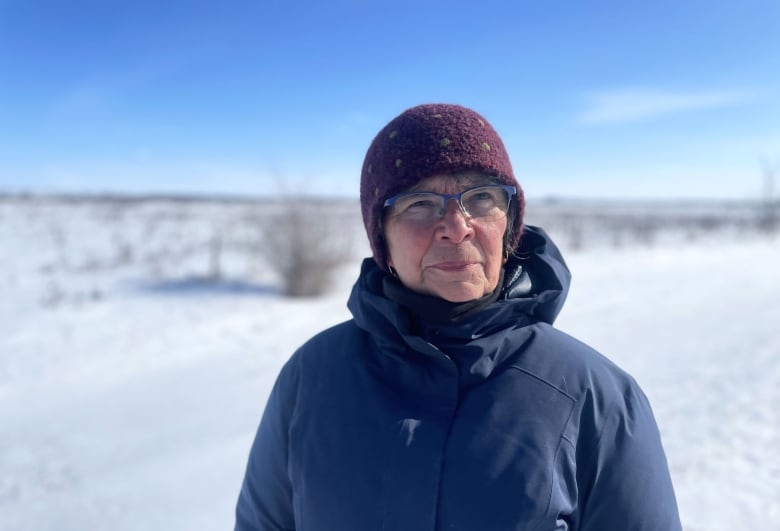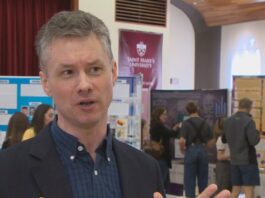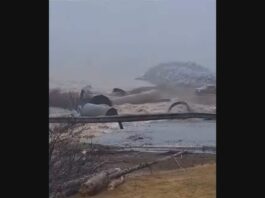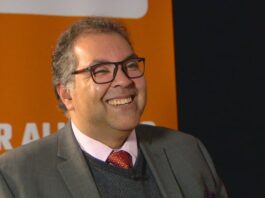
Our planet is changing. So is our journalism. This weekly newsletter is part of a CBC News initiative entitled “Our Changing Planet” to show and explain the effects of climate change. Keep up with the latest news on our Climate and Environment page.
Sign up here to get this newsletter in your inbox every Thursday.
This week:
- Grasslands store tons of carbon — and there’s a movement to protect them
- We’re nearing 1.5 C of warming. What does it signify?
- As Canadians call for greener pensions, pressure mounts for funds to cut ties with oil and gas
Grasslands store tons of carbon — and there’s a movement to protect them

Saskatchewan’s wild prairie is covered in a thick blanket of snow right now, but beneath it lies a storehouse of life.
Billions of tonnes of carbon are stored under Canadian grasslands, and they’re a critical tool in the struggle to maintain a healthy climate.
“Some people have likened them to upside-down tropical forests,” said Candace Savage (photo above), a Saskatchewan-based author and advocate for grassland protection. Like ancient forests, native grasslands are built up over centuries, but instead of locking carbon in trees, grasslands hold them inside the soil.
But native grasslands are among the world’s most endangered ecosystems. In North America, more than one million hectares are destroyed each year for cropland and urban areas.
“We’re slowly losing these places where we reflect and we are with the land,” said Kevin Wesaquate, a multidisciplinary artist from the Piapot First Nation, about 50 kilometres north of Regina.
Wesequate and Savage are members of the Swale Watchers, a community group working to protect a grassland area called Northeast Swale on the outskirts of Saskatoon. This month, the city council voted to increase the area spared from encroaching development. The announcement was a welcome sign for Wesaquate, but hardly the end of the struggle.
“It’s almost like I’m stepping into a bit of a time machine when I take a walk out into the swale,” he said. “We have come together to protect these sites.”
According to the Nature Conservancy of Canada, more than 70 per cent of Canada’s native grasslands have been lost; in Saskatchewan, it’s around 80 per cent. Not only that, but in Saskatchewan and Alberta, only about one per cent of what remains is protected.
Luckily, the movement to protect it has learned some things. For millennia, First Nations across the Prairies stewarded the grasslands they lived on, using controlled burns and grazing bison to keep grassland ecosystems in balance. Now, organizations like Parks Canada are integrating that approach, including communities and their livelihoods in grassland protection.
It’s been a years-long process.
“It took 15 to 20 years for us to figure each other out,” said Miles Anderson, a third-generation rancher who has lived next door to one of the continent’s largest protected grassland areas, Grassland National Park, which extends across almost 1,000 square kilometres in southern Saskatchewan.
When Grasslands National Park was created in the 1980s, Anderson says ranchers like him were required to keep their livestock out of the park boundaries. Over the years, this exclusion dealt a blow to endangered species like the greater sage grouse.
“The population just crashed,” said Anderson, as the grouse chicks couldn’t find enough food in the long, dense, ungrazed grasses.
Done right, grazing can help a variety of plant types to coexist. And animal manure can keep those plants healthy by fertilizing the soil. That’s good, because different grassland species like the greater sage grouse rely on different types of plant ecosystems.
Until about 200 years ago, wild bison were prime grassland grazers, and a critical animal for First Nations across the Prairies. Their populations have since been devastated. There are programs aimed at restoring bison herds, including a recent project led by the Key First Nation in southern Saskatchewan, but cow grazing can also help fill the gap.
Anderson says that led to a relationship with Parks Canada: his cows can graze within the park boundaries, and the park gets the biodiversity benefit.
Anderson says determining how much to graze requires skill and some trial and error. It also takes a lot of land — which has become more expensive in Saskatchewan and across the prairie. Crop cultivation, meanwhile, tends to bring in more profit, but it requires tearing up the carbon-rich earth that grasslands store, releasing much of that carbon into the environment.
Today, Anderson advocates for programs to support ranchers to steward the grasslands they work on.
In an emailed statement, the Province of Saskatchewan highlighted the region’s Prairie Resilience climate change strategy and its Climate Resilience Measurement Framework, which aims to increase protected areas from 9.8 per cent to 12 per cent by 2025.
Environment and Climate Change Canada commented that it has invested more than $5 billion in nature-based climate solutions, including grasslands, and highlighted its Nature Smart Climate Solutions Fund, which includes a focus on securing unprotected grasslands.
Candace Savage says the recent win to protect the swale in Saskatoon may be magnitudes smaller than the landmass of Grasslands National Park, but it provides an opportunity for local communities to get acquainted with the wonder of grasslands and to advocate for their protection.
In her years of writing about the Prairie landscapes, she’s seen a shift in that direction.
“One of the things that has changed is more reverence for grasslands. More appreciation of them, more protection for them, more restoration,” she said.
“They’re patient places,” she said. “They remind us that the choices that we make today are going to have impacts over decades and generations.”
— Zoë Yunker, with files from Leisha Grebinski
Reader feedback
In response to Rohit Joseph’s piece last week on winter biking, Kenneth Kepler wrote:
“I did a lot of winter biking between 2011 and 2016. Salt was the problem. I used studded tires and coaster brakes, no problem. But the bike frames and fenders rusted quickly. One older bicycle I used (and liked) one day literally broke in two on my way home at night — rusted right through.”
Fabien Sicart:
“Despite my work location being quite far (45 kms) from where I live (downtown Hamilton), I use a ‘refurbished’ bike for most of my in-town commute, when possible. I have a front-mounted baby seat and a trailer for the kids.
Hamilton has been improving its bike lane infrastructure quite a lot in the last few years with proper separated bike lanes. The biggest problem in the winter is that when they plow, either they forget the bike lane or they push the snow ONTO the bike lane to clear the roads, making the bike lane not usable. To be fair, I noticed that this winter, bike lanes are starting to be cleared by a specific snowplow, so things are improving!”
Old issues of What on Earth? are right here.
CBC News has a dedicated climate page, which can be found here.
Also, check out our radio show and podcast. Just days ago, the world heard another warning from the United Nations on the need to act urgently to keep the planet below 1.5 C of warming. This week, What On Earth hears about the many solutions laid out in this new report, and how it can act as a “survival guide” as world governments take action on climate. What On Earth airs on Sundays at 11 a.m. ET, 11:30 a.m. in Newfoundland and Labrador. Subscribe on your favourite podcast app or hear it on demand at CBC Listen.
***And watch the CBC video series Planet Wonder featuring our colleague Johanna Wagstaffe here.
The Big Picture: Nearing the 1.5 C warming threshold

Earlier this week, the UN’s climate panel released a synthesis report that says the planet is likely to reach 1.5 C of warming (since preindustrial times) in the “near term” — likely “sometime in the 2030s,” according to UN Secretary General Antonio Guterres. Keeping warming under 1.5 C was one of the aims of the Paris Agreement, but given the current rate of fossil fuel use, it is becoming increasingly unlikely that we will be able to avoid it.
Right now, the planet is estimated to have warmed between 1.1 C and 1.3. C, and the consequences are already clear, from more deadly wildfires and flooding to droughts. Every report from the Intergovernmental Panel on Climate Change (IPCC) paints an increasingly dire picture of life on Earth in the coming century, but succumbing to defeatism is not an option, says Katharine Hayhoe, global chief scientist for conservation group Nature United. “Every bit of warming matters. And if we give up, we are doomed,” she said.
The latest report is unequivocal about what human society needs to do: reduce carbon emissions at lightning speed. But it also demonstrates the ways in which collective action has worked. Before the Paris Agreement was signed in 2016, the world was on track to reach 3.5 C of warming by 2100. Since that historic accord, however, we are on track to reach 2.5 C. With announced pledges from countries, it could be limited to 1.7 C. And if we reach net zero by 2050, it could limit warming to 1.5 C.
The subtext is simple: co-operation works. We just need to expand and expedite our efforts.
Hot and bothered: Provocative ideas from around the web
- Australians could be the first people in the world to confidently compost their worn-out clothing after the country’s standards organization accepted technical specifications for compostable textiles, proposed by a lingerie entrepreneur.
- A new data centre under construction in Lévis, Que., will provide waste heat to greenhouses to grow food. Two Canadian researchers take a closer look in The Conversation, showing that while such projects have benefits, they aren’t a clear win for agriculture or the environment.
As Canadians call for greener pensions, pressure mounts for funds to cut ties with oil and gas

Despite mounting pressure from Canadians who want their money to stop supporting oil and gas, the majority of the country’s largest pension fund managers continue to invest in that sector — and are led by individuals with close ties to fossil fuel companies.
CBC News reviewed publicly available bios and resumés of leaders overseeing Canada’s 10 largest pension funds and found that eight organizations have at least one high-ranking member — either a board member or an executive — who is actively directing a company in the oil and gas sector.
Those companies include oil and gas production firms, pipeline operators, gasoline retailers and drilling rig contractors.
Current laws and regulations do not bar directors from holding roles at pension funds and companies in the oil and gas sector, said Barnali Choudhury, a corporate governance expert and a professor at Osgoode Hall Law School at York University in Toronto.
But Choudhury understands why it might raise questions for some. She encouraged members with concerns to contact their pensions boards to advocate for stronger climate action. CBC News spoke with several people who have been doing exactly that.
Teri Burgess, who teaches Grade 4 in Comox Valley, on Vancouver Island, said children today are growing up under the shadow of a changing climate, and the idea that part of her paycheque may contribute to that is beyond frustrating.
“It’s ridiculous to think that [pension directors] can serve the needs of their members as well as sit on another board,” said Burgess, who has two sons.
This past week, Burgess attended her union’s annual general meeting, where members passed a motion calling on the British Columbia Teachers’ Federation to develop a plan for their pension’s full divestment from fossil fuels by 2028.
Her pension fund is managed by the British Columbia Investment Management Corporation (BCI). According to a 2022 investment inventory update on BCI’s website, the teachers’ fund manager holds shares in a range of oil and gas companies, including ConocoPhillips, the company behind the controversial Willow oil drilling project in Alaska.
“I don’t know any colleague of mine in any school who wants to stand at the front of the room and say, ‘Hey kids … I’m going to continue to invest in something that I know is harming you,'” said Burgess.
BCI’s executive vice-president and global head of infrastructure and renewable resources, Lincoln Webb, is also the chair of the supervisory board of natural gas transmission network Open Grid Europe and a board member of Czech Gas Networks.
Neither Webb nor BCI’s media relations team responded to CBC’s multiple attempts to get in touch for comment.
BCI has acknowledged in previous statements that “climate change poses a systemic risk to the value of our clients’ portfolios and to the global economy” and said it supported “the global path of net zero.”
It’s one example of how, despite varying degrees of climate commitment and net-zero policies from eight of Canada’s largest pension fund managers, there continue to be overlaps between the oil and gas industry and those funds, which represent about $1.96 trillion in net assets.
“It seems to me … impossible to serve both the interests of a major fossil fuel company on the one hand, and the interests of the pension fund and its beneficiaries on the other hand,” said retired economist Roy Culpeper, who lives in Ottawa and used to work in the federal Department of Finance.
While day-to-day investment decisions are not generally made by board members, they do typically set strategy and approve overarching investment policies.
CBC reached out to the eight pension organizations examined for this piece. None of them agreed to an interview. Three responded with written statements.
A spokesperson for the Canada Pension Plan Investment Board said via email that “it does not make sense to suggest there is a conflict of interest because a director has experience in one specific area.”
The Caisse de dépôt et placement du Québec (CDPQ) highlighted that as of June of last year, it had divested from 90 per cent of its oil production assets. A spokesperson for Alberta pension fund manager AIMCo said “board members are not selected on the basis of their particular sectoral experience, but rather the complement of skills and acumen that they bring.”
Sustainable finance organization Shift Action tracks the climate commitments of Canada’s largest pensions and recently graded their sustainability in a report card.
Patrick Derochie, senior manager for Shift Action, said while some funds are showing signs of progress through net-zero targets and more investment in renewable energy, “Canada is behind on this issue.”
The New York state pension fund and Europe’s biggest pension fund (APB) have both made the decision to drop fossil fuel stocks. In Canada, CDPQ is the only one of Canada’s largest pension funds that has committed to excluding oil producers from their portfolio, but not gas.
Derochie wonders whether directors who are on the boards of fossil fuel companies are trying to advance the interests of oil and gas at the pension fund.
“That pension fund director who has to serve the interests of Imperial Oil … that’s a very different thing than the best interests of you or I.”
— Jaela Bernstien
Click here to read the full story.
Stay in touch!
Are there issues you’d like us to cover? Questions you want answered? Do you just want to share a kind word? We’d love to hear from you. Email us at whatonearth@cbc.ca.
Sign up here to get What on Earth? in your inbox every Thursday.
Editor: Andre Mayer | Logo design: Sködt McNalty












